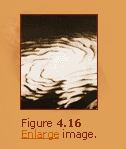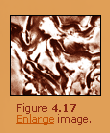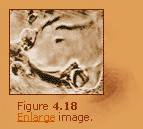|
|

Polar Ice Caps
The existence of
polar ice caps also makes Mars different from the Moon and Mercury.
Both Martian poles have ice caps that advance and recede with seasons.
The seasonal cap consists largely of carbon dioxide ice, but the more
permanent cap that remains during the summer is probably made of water
ice, at least in the North Pole. Large amounts of water were detected
over the North Pole during the northern summer but not over the South
Pole during its summer.
 |
 |
Figure 4.16 is a view of the permanent northern ice cap. The ice
cap is about 1000 km across. The dark lines were mostly valleys
or southward-facing escarpments that were free of frost. The cause
of the pattern is not certain, but it may be the result of erosion
by high winds spiraling out from the pole. A closer look of the
northern ice cap is given in the following image (Figure 4.17) .
This view is about 90 km across, and it is difficult to visualize
because of the confusing effects of the frost.
|
The bright areas are covered in frost and the dark areas are frost-free.
The fine patterns of striation were caused by layered deposits that underlie
the frosts. Similar deposits occurred on both poles and they could extend
outward to about 10 degrees in latitude from the actual poles. They are
believed to be a mixture of dust and ice that has slowly accumulated over
the years. Differences between successive layers were probably the result
of variations in dust storm activities. Such variations would affect the
amount of dust particles in the atmosphere and hence the amount deposited
on the poles. The layering, therefore, represents a record of climate
variations during the recent geologic past. These layers have no impact
craters, suggesting that they are relatively young.
|
Layered deposits in the North Pole are always covered with frost.
However, the southern ice cap is smaller and much of the layered
deposits are not frost covered in the summer (Figure 4.18). This
picture shows clearly the layered deposit overlying an older, cratered
terrain partially filling a crater at the lower right hand corner.
The contrasting smoothness of the surfaces is striking. This picture
is about 200 km across.
|
 |
< back 1 2
3 4
|



